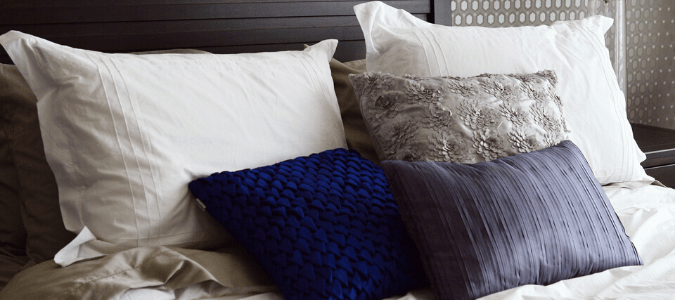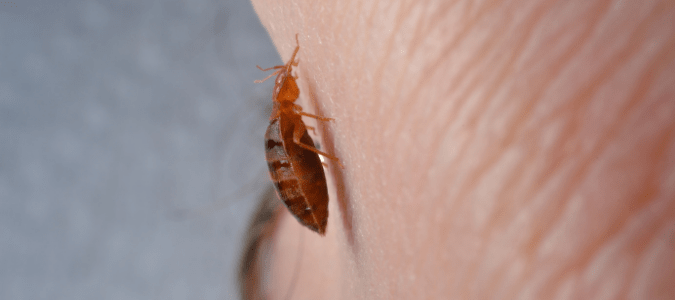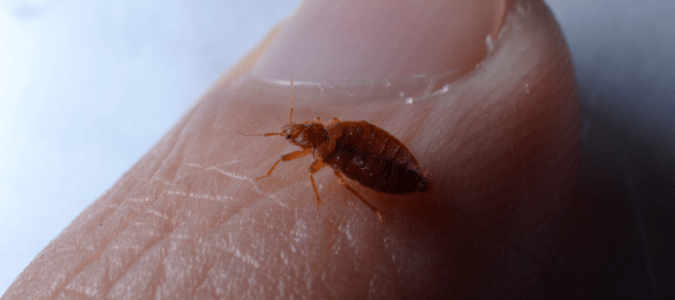
Some people wonder if bed bugs give off a particular scent that can signal their presence in the home. Others are wanting to know whether bed bugs themselves possess a sense of smell; if they do, there might be odors that bed bugs find repellent that could be used to deter them from infesting people’s homes.
Bed bugs do give off a certain, unpleasant scent when they’re disturbed, which is related to the pheromones they emit when alarmed. Some people have described it as a sweet or coriander-like scent, while others have said it’s a musty or moldy smell. This scent might not be obvious to everyone, however—some people can’t smell it at all—and it might only be detected when there are lots of bed bugs present, indicating a heavy infestation.
This means that if there are bed bugs present somewhere in your home, chances are, you won’t smell them—and if you do, you may not recognize their scent for what it is. The best way to determine whether you have bed bugs living in your bed, furniture or other areas of the home is first to look for common signs of a bed bug infestation. If you find any of the signs, the next step is to reach out to a pest management professional for proper diagnosis and treatment of the problem.
Here are some of the common signs of a bed bug infestation:
- Red, itchy bumps on your skin (or on the skin of anyone else sleeping or spending time in your home). These bites often show up on people’s arms and legs—the areas of skin that are most often exposed while people are sleeping—but they can show up anywhere. They may also be grouped together in lines of several bites. Bed bugs often bite their human victims, feed on their blood at that site for a few minutes and then move a few millimeters away to bite and feed again, resulting in lines of closely-spaced together bites.
- Bed bug sightings. You can see bed bugs with the human eye and these pests are small, flat, brown, wingless, oval-shaped insects, about the size and color of apple seeds. Spotting a bed bug, whether alive or dead, is a sign that others are somewhere nearby, and eggs or nymphs might be in adjacent areas as well. Bed bugs typically hide during daylight hours in small, hidden spaces, such as along the piping that runs down the sides of most mattresses. They might also hang out on other furniture where people spend lots of time, or on the walls, behind framed pictures or even between floorboards.
- Cast-off bed bug exoskeletons. Bed bugs shed their skins as they pass through the various stages of their life cycle. Thus, people sometimes find these insects’ shed skins in their beds or in other areas.
- Black, brown or rust-colored spots on your mattress, pillows, sheets or other areas. Tiny black spots on your sheets or bed that bleed like pen ink could be bed bug excrement. Brown or rust-colored spots in the same areas could be blood spots left over after a feeding.
Bed bugs do possess a sense of smell, and they emit alarm pheromones, as well as pheromones for reproductive purposes. Pheromones work based on scent, and insects and other types of animals are also known to use pheromones to communicate with one another. Some scientists believe bed bugs use their sense of smell to find human hosts to feed on.
Even though bed bugs do have a sense of smell, this hasn’t yet translated to a scented pest control product that successfully repels these pests. Scientists believe bed bugs’ ability to detect each other’s pheromonal scents is close-range only. While longer-range pheromone-based approaches to pest control are still a possibility for the future, for now, there are no effective scent-based products for repelling or otherwise controlling bed bugs.
Bed bugs are experts at what they do, and one thing they are particularly good at is hiding during daylight hours. This makes these creatures difficult to find if you don’t know where to look, and very challenging to get rid of. Female bed bugs might live for less than a year, but they can lay multiple eggs every day until they die. This can turn into quite a big problem in very little time. Like many insect pests, bed bugs must be eliminated via a multi-pronged approach that targets these pesky pests at all stages of their life cycle, including eggs and nymphs. For these reasons, it’s wise to hire a pest control specialist with extensive experience in eliminating bed bug infestations to diagnose and address your pest problem, rather than trying to tackle it on your own.
When compared to other types of pest infestations, having bed bugs can be extremely frustrating, partly because there are many myths surrounding these creatures that make finding accurate information more difficult. As a homeowner, you likely have many questions and worries about how a bed bug infestation can affect your life, including whether or not bed bug bites can make you sick.

Can Bed Bug Bites Make You Sick?
Bed bugs do not spread disease, so in that sense, they can’t make you sick. To varying degrees, however, these pests can cause other health issues for people. Bed bug bites can result in significant itching in many people, for example, and if scratched, the bite sites can develop more serious secondary infections.
Bed bug bites don’t affect everyone the same way, of course. Different people have varying reactions to this type of insect bite, depending on their personal physiology and allergic reactions to histamines. These bites feel at least mildly itchy to most people, and many find them to be intensely itchy. Unfortunately, these itchy bites often lead people to scratch compulsively, and scratching can create open wounds that are vulnerable to secondary infections like staph or MRSA. Bed bug bites also may develop into blisters, which is one difference between bed bug bites and mosquito bites. These blisters can burst when scratched, further leaving the skin vulnerable to infection.
Bed bugs typically bite people on areas of the skin that they can reach most easily in the darkness—that is, exposed skin. Thus, many people find bed bug bites on their arms, legs, feet and even faces. Bed bug bites can show up anywhere on the human body, however. They often show up in lines of close-together bites, since bed bugs typically bite people in multiple spots, moving with each fresh bite just a small distance from the previous bite site to take their next blood meal.
If multiple people are living together in a home but only some of them seem to be suffering from bed bug bites, it may mean either that one or more of the household members simply aren’t as affected by bed bug bites, or that the bed bugs are so far infesting only a certain room or area of the home. This is why it’s important to take precautions so that bed bugs won’t be transferred from the primary infestation area to other parts of the home.
For example, if you think one bed in your home may have bed bugs, never take off the sheets or blankets and move them to a different bed or couch to sleep there, since you could unwittingly be bringing bed bugs along that are hiding in the covers. That’s the main way these tiny pests travel from one area to another, whether it’s from one room to another or one country to another: They hitchhike in people’s clothing, luggage and other items.
If you suspect or know that bed bugs are living in your bed, washing your sheets and drying them on a high-heat setting can kill off any bugs that may be in your sheets, along with any eggs or nymphs. The bugs, eggs and nymphs living in your mattress or other areas, however, will have to be eliminated in some other way. While there are some home remedies that claim to work, such as using lavender to repel bed bugs, many of these methods are not scientifically backed. By contacting a reputable pest management professional, you can feel confident that your professional will know many different strategies and products that can be used to eliminate bed bugs from the home.
Above, we mentioned that bed bug exoskeletons are one common sign of a bed bug infestation, but you may be wondering what exactly these exoskeletons look like and how you can get rid of them, along with the bed bugs that shed them.

What Do Bed Bug Casings Look Like?
Bed bug casings are also called cast skins—the exoskeletons that bed bugs shed during certain phases of their life cycle. Like other shed insect exoskeletons, bed bug casings look a lot like bed bugs themselves, except empty and far paler in color. They can range in size from very small, if they were shed by a bed bug nymph, to somewhat larger, if shed by an adult bed bug.
Bed bug casings are a common sign of a bed bug infestation. If you believe you have found bed bug casings in your bed, sofa or any other area of your home, it’s a good idea to have a pest control specialist inspect the area to confirm the presence of bed bugs (or some other type of insect pest, as there are several other types of bugs that look like bed bugs).
A good, deep vacuuming can help to get rid of bed bugs and their casings, but vacuuming often misses the eggs and nymphs, since these are smaller and harder to see. Getting rid of clutter in the infested area can also help in the effort to eliminate these pests, although bed bugs can infest any type of home, regardless of how neat or clean it may be. Pest control professionals are your best bet for tackling a bed bug infestation, as they can take a thorough and comprehensive approach and recommend steps that household members can take to prevent a future infestation.
ABC Can Handle Your Bed Bug Problem
There are many reasons why it is so difficult for homeowners to get rid of these pests on their own—bed bugs breed quickly, hide in tiny spaces and disperse eggs in hard to see areas. If you’re dealing with a bed bug infestation, you can count on the bed bug control specialists at ABC Home & Commercial Services to provide you with effective treatment options. With over 70 years of experience in the pest control industry, ABC is staffed with professionals who can create a specialized treatment plan for your problem, so your life can get back to normal.
